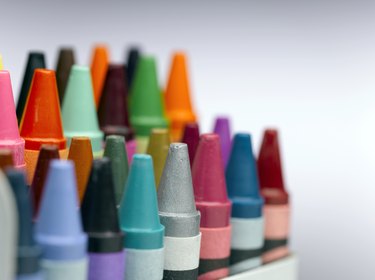
If your in-house or client workflow includes a project that requires the look of crayon strokes -- for a children's charity poster or just to make a whimsical impression -- Adobe Photoshop's default brushes probably lack the look you want. Rather than purchase custom brush presets, or draw your artwork with real crayons and scan it into Photoshop, you can set up your own brush preset. Photoshop's settings and options offer the controls you need to create a brush that can simulate the look you want.
Brushes Panel
Video of the Day
When you open the "Window" menu and choose "Brushes," you access the nerve center of brush tip creation. The list of settings belies the depth of the options you can access through this panel, as you'll quickly discover when you click on what look like category labels with check boxes. Most of these listings include sets of options you access only by clicking on their names. To create a brush preset, start by choosing a brush tip to serve as the basis for your crayon. When you click on the "Brush Tip Shape" listing, you can scroll through a list of presets and see the options they include. Find the "Soft Round 45" brush and click on it to select it. As you place your cursor over the brush-preset icons in the list, you'll see their names pop up as tooltips.
Video of the Day
Texture
To customize the basic soft brush you just selected, begin by adding texture to it. Clicking on the "Texture" setting category activates it and reveals its options. It's difficult to assess the default textures based on the thumbnails you see, but to access the one you want, you'll need to load another set into Photoshop. While you're viewing textures, the flyout menu at the top-right corner of the Brushes panel gives you access to other texture libraries. Choose "Artist Surfaces" and append them to your current list of choices. When you find the icon for "Wax Crayon on Vellum (150 by 150 pixels, Grayscale Mode)," click on it to select it.
Dual Brush
Photoshop's dual brushes combine two brush tips into one stroke that only paints the portion of each brush tip that overlaps the other. If you activate the "Dual Brush" check box in the Brushes panel and click on its listing, you can choose from the same gallery of presets you use to select single brush tips. In this case, you want the "Spatter 14 Pixels" brush. Adding it to the Wax Crayon texture and the big soft starter brush gives you a tight stroke with the distinctive grainy edges of a crayon. To accentuate the graininess and simulate the look of an older, dryer crayon, you can turn on the "Noise" setting in the Brushes panel. Unlike most of the settings categories in this panel, Noise offers no subsidiary options.
Considerations
Once you've created your brush, you'll need to save it as a brush preset to avoid replacing it with the next brush you select. The "New Brush Preset" option in the Brushes panel flyout menu opens a dialog box in which you can name and save your preset. Photoshop always adds new presets to the end of the list, and unlike many of the program's panels, Brushes doesn't allow you to move presets the way you'd rearrange document layers. For an extra touch of realism when you draw with your new brush, isolate crayon colors on individual layers so you can control how and where they interact.